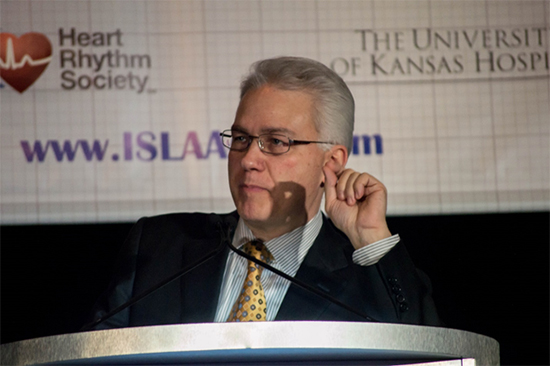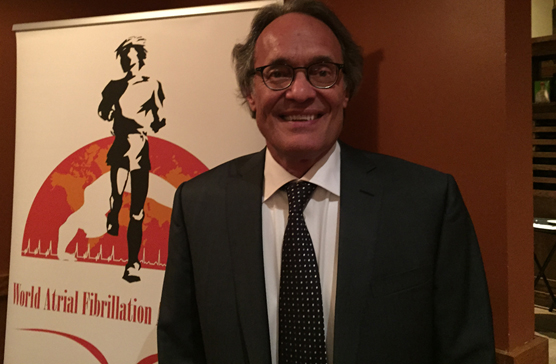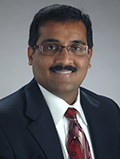This entire journal is dedicated to the science related to Atrial Fibrillation (AF) and yet we cannot publish enough about this most heterogeneous disease process that is a lot more complex than our current understanding. There are many interesting and well known facts about AF. It is common knowledge that it is the most common arrhythmia that affects several millions of people across the globe and remains the number one cause of stroke. Thanks to advances in therapies that there is increasing awareness both in the professionals and lay public. With billions of health care dollars that get spent in treating the disease and the related complications, AF is slowly moving up on the notoriety scale with most of the world’s health care delivery systems.
The important question that remains partially answered is – how do we recognize this beast of a disease that has such a profound social and personal impact? The current status of AF is what CAD used to be in the early 60s. Understanding the pathophysiology, early recognition, appropriate tools of diagnosis, intervention and prevention took more than 5 decades of intense work from all fronts on CAD to finally lose its place to cancer as the number one killer of the human race. AF is slowly creeping up in its prevalence and has evolved to be a familiar subject of health related discussions at all levels. The number of scientific publications that targeted AF alone has increased by 1500% in the last decade. There are more than 100 medical device and pharmaceutical companies that have AF diagnosis and or treatment related products in their portfolio. More than 15% of hospitals in the United States now have Centers of Excellence in Atrial Fibrillation Management or have the infrastructure to offer AF related therapies. All these growing facilities and access to therapy still seems to be not sufficient enough to make a significant dent in the overall clinical morbidity and mortality imparted by AF. Some of the most easily recognizable problems to effective diagnosis and therapy for AF remain obvious but still worthwhile to discuss. Awareness and understanding of the disease is still relatively low both in patients and health care professionals. This issue seems more profound in the developing and underdeveloped nations. Significant inequality of patient access to appropriate and timely care remains another major bottle neck. This inequity seems to be determined by the regional, racial and socioeconomic differences in access. Lapses in communication for a more effective care continuum once the patient is recognized to have AF and standardization of therapy that is evidence based and guideline driven stands out prominently why AF therapy is complicated. Limited effectiveness of the currently available treatment strategies limits our ability to tackle AF full force.
Patient advocacy and awareness campaigns are very important to promote the grass root level engagement in our fight against AF worldwide. This strategy has been proven to be very effective in successfully eradicating several communicable diseases and prevent/treat several many chronic diseases. Several organizations have started working on the patient education front and one such body that has been doing commendable work is Global AF Alliance (GAFA) Foundation. This article highlights some of the important ground work this organization has been doing in the last few years. GAFA is a not –for-profit organization founded for the purpose of bringing together patients, physicians and industry world-wide for the common goal of improving the knowledge, awareness, and support for the management of AF. GAFA aspires to overcome both the cultural, linguistic, and geographical barriers among physicians who treat AF and the communication barriers that can exist between patients and their physicians by creating a common resource that is available to all. GAFA aims to use this alliance as a proactive tool in involving patients in their health care decisions regarding treatment of AF. It is important to provide people who have been affected by AF with adequate knowledge through the most current news and developments in research, information on prevention, management, and their treatment of AF, along with outlets for support and ways raise awareness in their community and on a more global front.
September has been recognized as the AF month. Taking this further GAFA has officially obtained a proclamation by the governments of states of Kansas and Arkansas to celebrate the second Saturday of September as the World Atrial Fibrillation Awareness Day. The goal is to have the federal government pass a resolution to recognize the same on a national level. GAFA worked together with numerous cities internationally to plan events that continue to bring attention to the prevalence of AF in society and its potential impact on patient and family quality of life. These events included educational talks and fundraising activities to benefit investigator initiated research for the treatment and management of AF. There has been a significant focus not only on diagnostic treatment and tools, but also on alternate forms of AF management such as yoga and lifestyle changes. The Arkansas chapter of GAFA led by Dr. Raj Chaka and team have done exceptionally well in organizing big run and educational event in the last few years.
On a more global level GAFA is striving to decrease the knowledge gap between nations with well-established AF treatment centers and countries with few learning opportunities about AF management through networking that will allow interested physicians to partner with electrophysiologists. The Global Atrial Fibrillation Alliance pledges to create an active, informed, and united community in our endeavor to provide the best healthcare possible for AF.
As a part of the World AF Awareness Day, GAFA recognizes individuals and organizations who have done exemplary work in the field of AF with the GAFA ambassador awards. This year the GAFA physician ambassador award was given to a house hold name in the AF world and editor-in-chief of JAFIB Dr. Andrea Natalee. Dr. Natalee serves as the Executive Medical Director of the Texas Cardiac Arrhythmia Institute at St. David’s Medical Center, Austin, Texas. He has distinguished appointment in multiple other institutions. He is a true global physician whose foot print spreads from Italy to USA to China. Born and raised in Italy he moved to the United States 1991 and continued his electrophysiology research and clinical work. Built on the solid foundation of his early scientific interests he continued to challenge the field of electrophysiology with his innovative techniques and provocative ideas. He infused significant energy into a static field and redefine the direction of its progress.
Dr. Andrea Natale, recipient of the GAFA Physician Ambassador of the Year Award for 2015

Dr. Natale has more than 800 peer reviewed abstracts and manuscripts that were published and presented in various international journals and meetings. Despite a very busy clinical schedule he manages a large research operation. He is the most prolific researcher that the field has ever seen. He has received many awards in recognition of his work, including the most recent American College of Cardiology’s Simon Deck Award for outstanding scholarship in 2014. He popularized the role of intracardiac echo in EP procedures. The roving lasso approach use intracardiac echo during Pulmonary vein antral ablation can be otherwise called the Natale approach. He is one of the first to recognize the arrhythmic role of left atrial appendage and the value of effective isolation of the same for raising the success bar for persistent AF undergoing ablation therapy. He has been an invited speaker at more than a 1000 national and international meetings and directs five major international meetings every year. Dr. Natale has the credit of being an amazing mentor to several electrophysiologists around the world. His trainees cover many countries in the world. I had the personal pleasure of being one of his trainees during my EP fellowship years at the Cleveland Clinic. He remains an amazing source of inspiration for an entire generation of people for work ethic, dedication to medicine, scientific advancement, compassionate care and the power of human determination.
Mr. Shannon Dixon, recipient of the GAFA Patient Ambassador of the Year Award for 2015

The GAFA patient ambassador award for 2015 went to Mr. Shannon Dickson (Figure-2). Sixty three year old Shannon Dickson's early adult life included a successful career as owner of a design-build mechanical engineering firm focused on largescale alternative energy projects for cooling and water heating of hotels, high-rise condominiums and hospitals in the state of Hawaii. By 1988, his company was absorbed by Hawaiian Electric, the state’s largest utility, and morphed into their alternate energy division. In 1992, at age 40, a family history of Atrial Fibrillation caught up to Shannon, beginning his almost quarter century experience of dealing with progressively evolving AFIB, which ended in a highly successful two-step persistent AFIB ablation process performed by Dr Andrea Natale, including LAA isolation in the second procedure.
At the beginning of 2014, Shannon was asked to take over ownership and editorial duties of the website: www.afibbers.org and companion bi-monthly newsletter, The AFIB Report. This website represents the oldest AFIB-centric patient education and advocacy resource on the web. Shannon’s long and eventful personal AFIB history, spanning many evolutionary changes in AFIB treatment and understanding, combined with his avid patient advocacy work online, and by phone, with fellow AFIB patients from around the world over the past 12 years, brings Shannon to Kansas City this week to help celebrate World AFIB Day 2015
Dhanunjaya (DJ)Lakkireddy, MD, FACC, FHRS, Associate Editor JAFIB.
